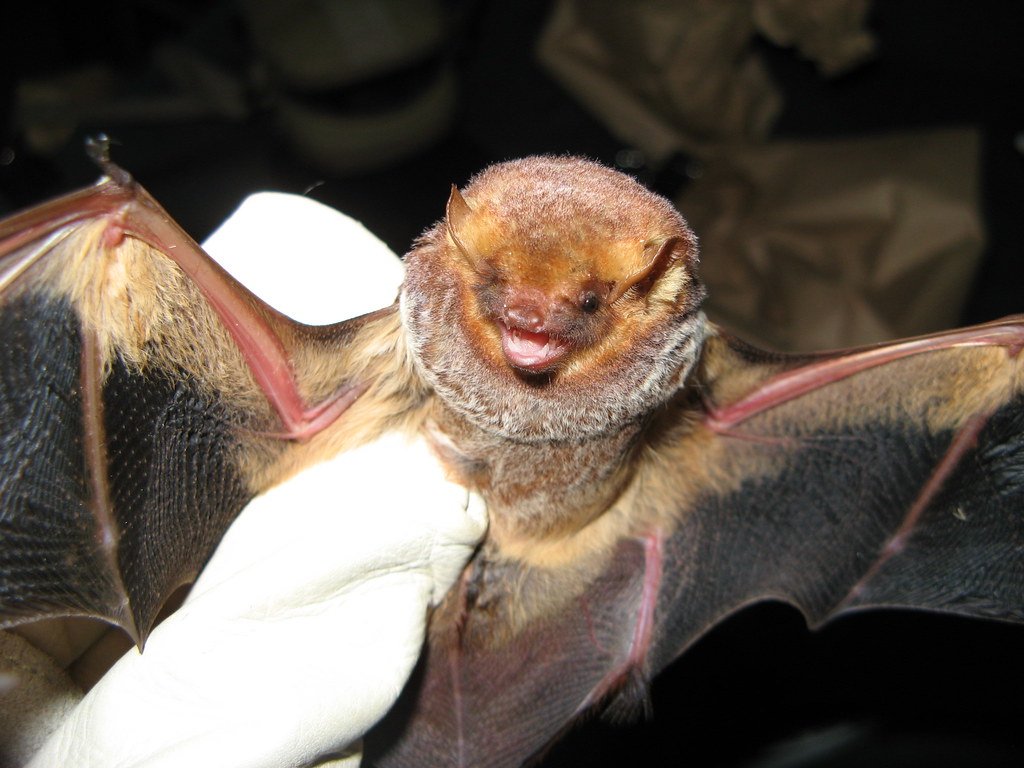Seminole Bat: Lasiurus Seminolus

The seminole bat species is typically found in the southern united states and central America. Compared to other bats, this species is medium-sized and has reddish frosted fur (similar to hoary bats).
This bat does not migrate based on weather conditions because it roots in environments that are consistently warm. Seminole bats also consider the availability of food when looking for a home. They require a large number of insects to feed on and trees that provide protection from ground predators.
Learn More: Bat Species List
Physical Characteristics Of The Seminole Bat
The Lasiurus seminolus (seminole bat) is a medium-sized bat with a wingspan of 11 to 13 inches and weighs between 0.3 to 0.5 ounces.
Seminole bats are often confused with other bat species. Close examination shows that their fur’s deep mahogany color differs from the eastern red bats’ reddish-orange color. Seminole bats’ fur is frosted at the tips, like hoary bats, but hoary bats are much larger.
The seminole bat is furred to its tail’s tip, and its fur spreads to its wrists along its underarms, ending with distinctive white patches on the wrists and shoulders that separate the Florida yellow bats from seminole bats. 1Go To Source nps.gov -“Seminole Bat”
Seminole Bat Diet
Seminole bats are insectivores. Like most bats, this species diet consists of mostly insects and this bat will strategically pick a roosting location near insect populations and a water source.
These bats will swoop down from their roosting spot to quickly snatch up medium-sized insects for a quick meal. Seminole bats are often observed hanging around light posts that attract insects such as moths and mosquitoes.
Insects That Seminole Bats Prey Upon
- Bees
- Dragonflies
- Beetles
- Grasshoppers
- Moths
- Flies
Seminole Bat Habitat
Seminole bats are found in mixed deciduous forests, and pine trees covered lowland forests. While many bats can be found hanging together, it is more common for this species to roost alone.
They hang on the southwest side of trees 1.5 to 6.1 m above the ground, sticking to the inside of clumps of Spanish moss, leaves, or loose bark. The area where they hang directly below the moss is free of other branches. This makes it possible for these bats to fall to begin their flight.
Leaf litter and other organic waste cover the ground under them. This decreases the amount of sunlight that is reflected when hanging on the trees.
In pine trees, roosting is more common, especially during childbirth and lactation. The trees chosen for roosting are taller and greater in diameter near the roost area than other trees. There are also selected trees that appear to be near forest edges that make easy flight paths. 2Go To Source animaldiversity.org -“Lasiurus seminolus seminole bat”
Range Of The Seminole Bat
The seminole bat appears across the United States from Florida, Northern Virginia, along the Coastal Plains, all the way to eastern Texas.
There has been no evidence of migratory activity, but it has been proposed that this species may migrate from winter to summer ranges. 3Go To Source fishesofgeorgia.uga.edu -“Seminole Bat”
Seminole Bat Species Behavior
The Seminole Bats live in solitary during winter and early spring. They don’t hibernate or conduct migration periods. During cold spells, they tend to fall into inactivity and wake up in warmer periods to eat. Most babies are born in late May or early June, but birth times are likely to vary in years with changing climatic conditions.
When temperatures are above 70°F, seminole bats emerge early in the evening all year round. They are fast, direct flyers, feeding above treetop level in flight or open areas as close as one meter above the ground.
They forge mainly over waterways, pine barrens, and clearings, but they are also believed to prefer edge habitats along rivers or roadways, often joining at dusk in large multi-species feeding aggregations.
They take advantage of prey drawn to street lamps and have been observed feeding for around half an hour between 8:00 PM and midnight, and again shortly before 2:00 AM. 4Go To Source tpwd.texas.gov -“Seminole Bat (Lasiurus seminolus)”
Reproduction Habits Of The Seminole Bat
During the fall, mating occurs in flight. In the winter, the sperm is assumed to be deposited, and then 1 to 4 young are born from late May to early June. The period of gestation is from 80 to 90 days.
On average, 3.3 young people are born per breeding season, which is rare since most bats only have one young person per litter. The young will fly as soon as 3 to 4 weeks after birth, and in the year following their birth, young are likely to achieve sexual maturity.
The babies are cared for by their mother until they are weaned and can fly, at which point they become autonomous, but for a brief time after the young begin to fly, there may be some mother and offspring connection.
Sources:
- “Seminole Bat – Everglades National Park (U.S. National Park Service).” National Park Service, www.nps.gov/ever/learn/nature/seminolebat.htm. Accessed 10 Dec. 2020.
- Walker, T. 2002. “Lasiurus seminolus” (On-line), Animal Diversity Web. Accessed December 10, 2020 at https://animaldiversity.org/accounts/Lasiurus_seminolus/
- Museum Of Natural History. “GAWW: Species Description.” The University of Georgia, 2008, fishesofgeorgia.uga.edu/gawildlife/index.php?page=speciespages/species_page&key=lseminolus.
- “Seminole Bat (Lasiurus Seminolus).” Texas Parks And Wildlife, tpwd.texas.gov/huntwild/wild/species/seminole. Accessed 10 Dec. 2020.
